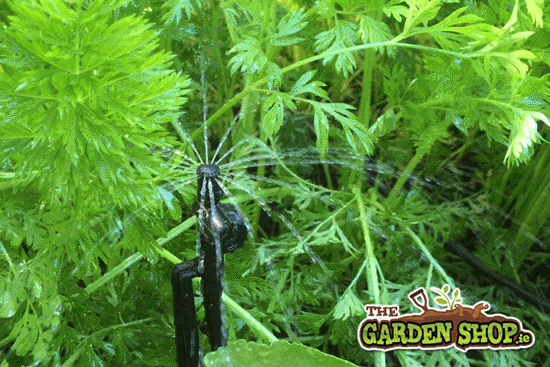Gardening Advice & Tips for Irish Gardeners
I wasn’t sure if we would ever get there but this weekend I found myself installing an irrigation system in my greenhouse & raised beds. With the current dry weather, watering of plants, vegetables & especially raised beds & greenhouses becomes a necessity that can take up a lot of time if the proper watering system is not in place.
When we experience an extended period of dry weather our plants growth rate slows down as stress levels increase. In some cases and especially with vegetables, periods of dry weather can also lead to bolting and irregular shaped fruits and roots.

Onions, garlic, spinach, pak choi, coriander, chives, parsley and fennel are all prone to bolting in dry conditions and so the only solution is to water by little and often. But with a busy lifestyle keeping on top of watering would rarely take priory.
Fruits including tomatoes require a regular water supply for prolific fruiting and to avoid split fruiting and blossom end rot. Blossom end rot is caused to infrequent and too much watering.
Courgettes, pumpkins, squash and cucumbers who develop large watery fruits also require a regular water supply to encourage fully formed fruits.
Knowing that my vegetables were suffering due to the lack of water even though I had been spending a number of hours each week filling watering cans I realised a more automated system was required.
After installing my basic irrigation system all I need to do now is attach my hose to my tap and run the water for 20 minutes each morning. This means no more running around with watering cans and it also means that my vegetables receive a balanced amount of water, at the same time each day and the water is going where it is needed – right to the plant’s roots.
Steps in setting up your own irrigation system
- Draw a plan of where you want to water and determine the best route from tap to site
- Choose the right sprinkler or drippers. I find that the sprinkler heads are most effective at covering a larger area and they are quick and easy to install. The drip feeders are good for ensure a more steady and accurate water supply is going where it is needed. So, if you are concerned about the water charges, then the dripper system would be more suitable
- Time is needed to calibrate and set up a watering system but once you get it right you won’t need to concern yourself with watering again.
- You will need a series of Elbow & Tee connectors to route your feeder hose from tap to site. I found that a lighter comes in handy when fitting the connectors to the hose. Using a cigarette lighter allows you to heat up and hence soften the hose piping, making fitting the connectors that bit easier.
- The final stages of setting up an irrigation system varies depending on the type of watering heads you choose.
To summarise
- The dripper heads: These drip small amounts of water continuously from the feeder hose. Determine the spacing between each dripper and using a hole punch make a hole in the feeder pipe for each individual dripper
- The Spectrum sprayers. These spout water out to a radius of approx. 20cm and are ideal for single plant pots, trays, containers or baskets. They are also suited to shrubs or in-between hungry vegetables such as pumpkins or squash
- The Spectrum Sprinklers: These powerful sprinklers can spout water out to a radius of 2m making them ideal for vegetable plots, flower beds and raised beds. Space them 2 or 3 m apart

